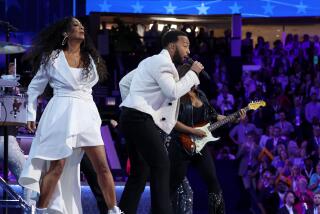Conventional Gear
- Share via
SAN DIEGO — I saw a lady with a large and very strange hat, so it does bear a resemblance to other political conventions.
--1980 presidential candidate John Anderson, about the Reform Party’s first political convention this week
*
OK, so maybe Nancy Boston’s giant silver elephant-shaped belt buckle wasn’t the easiest item to get past a metal detector at the entrance to the GOP convention hall. But the Texas delegate just had to bring it, she said, since it has accompanied her to major political events since she bought it in New Orleans at the 1988 convention.
And the red, white and blue sequined vest with the silhouette of Texas? How was she supposed to leave that at home in Bell County? That the delicate yellow rose corsage at her shoulder was lost in all the glitter didn’t matter, either. As a bona fide, Gov. George Bush-certified “Yellow Rose of Texas” for community service, Boston wore the flower proudly.
The concept of style is always relative, so perhaps it is not a surprise that as the four-day Republican infomercial draws to a close, the abundant Americana that was startling at first is beginning to look positively normal: caps adorned with stuffed elephants, Uncle Sam outfits and the entire Betsy Ross-on-acid catalog of flag-inspired sportswear.
It seems only fair at this point to excerpt the applicable portion of the 1996 Republican platform: “We support a constitutional amendment that will restore to the people, through their elected representatives, their right to safeguard Old Glory. We condemn Bill Clinton’s refusal, once again, to protect and preserve the most precious symbol of our Republic.”
Which gives rise to an obvious question: If some of these clothes don’t represent desecration of the American flag, what does?
The conservative kitsch swap meet, taking place in the convention center, is where the trend is in its fullest flower. The place bustled with customers, but some vendors have been disappointed in the location.
Trish de la Rosa sold silver jewelry, most of which was naturally based on the ubiquitous pachyderm. A former San Diego County field deputy for Sen. Dianne Feinstein (D-Calif.), De la Rosa said business had been slower than she’d hoped, since she and other vendors had initially been told they would be in a site open to the public. Instead, they were tucked away on the third floor of the convention center, able to do business only with credentialed attendees.
Her salesgirl wore a dramatically awful flag-colored hat, with jester points and jingle bells.
Would you be caught dead in that hat outside this hall? someone asked the girl.
“No way,” she replied.
Made in Nepal, the hat sold for $35, and probably would have cost at least twice that if it had been made in the U.S. (“A lot of people have been asking me if this stuff was made in America,” said De la Rosa. “They buy it anyway.”
*
When folks were not dressing for effect, business attire was the prevalent mode. Men began the days in suits, but outside in the wilting heat and humidity, shirt sleeves were the order of the day.
Elizabeth Dole has donned the solid, bright and telegenic suits that typify her role as the candidate’s wife. More than one observer has remarked on her extraordinary ability to keep her cool when others are mopping their brows.
Few people are wearing hats that could be described as normal. As any fashion historian knows, most men stopped wearing hats after JFK’s 1960 election.
And while this may be an unprovable assertion, it seems that GOP men have found a replacement for the now-disfavored hat: They have adopted the unmussable hairdo.
If the Republicans prevail in November, Americans may witness the start of a male hair trend. After all, Bob Dole (whose gray roots were in need of serious retouching by Wednesday), joked in 1985 that Jack Kemp was pushing for a “$10,000 deduction for hair spray.”
This could prove a liability for opportunists. You look at some of these stiffly coiffed big shots and, frankly, there’s no way of telling which way the wind blows.







